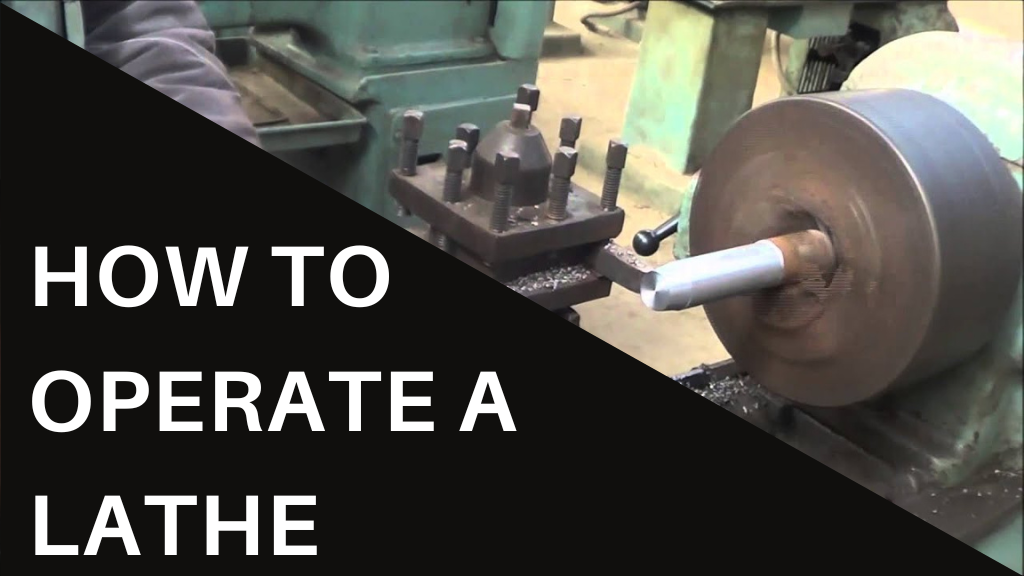A lathe is a machine tool primarily used to shape metal or wood by rotating the workpiece against a cutting tool. It’s a cornerstone in manufacturing, capable of performing operations like cutting, sanding, knurling, drilling, or deformation, turning raw material into precise components with incredible accuracy. In this Article, we will explore How to Operate a Lathe.
Importance of Safety in Lathe Operation
Before diving into the specifics of lathe operation, it’s critical to emphasize the importance of safety. Operating a lathe involves sharp tools, and high-speed rotations, and requires your undivided attention to prevent accidents. Always wear appropriate safety gear, including eye protection, and ensure you’re familiar with your lathe’s emergency stop features.
How to Operate a Lathe
Preparing for lathe operation is a critical step that ensures the safety, accuracy, and efficiency of all your machining projects. Before you begin working on any piece, understanding the preparation process and having all the necessary tools and equipment at hand are imperative. Here, we’ll delve into the essentials of preparing for lathe operation, including the tools and equipment you’ll need and how to set up your lathe correctly.
Essential Tools and Equipment
Operating a lathe, whether for woodworking, metalworking, or any other material, requires a specific set of tools and equipment. Each item plays a crucial role in the process, ensuring precision and safety in your work. Here are the key tools and equipment you should have:
- Cutting Tools: Depending on your lathe type and the material you’re working with, you’ll need an assortment of cutting tools. For wood lathes, different chisels such as gouges, skew chisels, and parting tools are essential. Metal lathes require carbide-tipped tools or high-speed steel (HSS) tools for different operations like turning, facing, and threading.
- Measuring Instruments: Precision is key in lathe operations, making measuring instruments indispensable. Callipers (digital or dial), micrometres, and dial indicators help measure workpiece dimensions accurately, ensuring your project meets the required specifications.
- Safety Equipment: Safety cannot be overstated when working with lathes. Essential safety gear includes eye protection (safety glasses or face shields), hearing protection (earplugs or earmuffs), and protective clothing (avoid loose clothing and jewellery, and consider wearing gloves for handling rough materials before machining).
- Tool Holders and Inserts: For metal lathes, tool holders that secure the cutting tools and various inserts for different materials and types of cuts are necessary for efficient and precise operations.
- Workholding Devices: Chucks (three-jaw or four-jaw), faceplates, and centers are crucial for securely holding the workpiece in place during operations.
Setting Up Your Lathe
Once you have all the necessary tools and equipment, the next step is to set up your lathe properly. A correctly set up lathe is fundamental for achieving precise results and operating safely. Here are the key steps:
- Leveling the Lathe: Ensure your lathe is perfectly level before use. An unlevel lathe can cause inaccuracies in your work and increase wear on the machine. Use a precision level to check and adjust as needed.
- Securing the Lathe: Your lathe must be securely fastened to a stable surface to prevent movement during operation. This not only ensures safety but also helps in achieving precise cuts.
- Cleaning and Lubrication: All moving parts of the lathe should be clean and well-lubricated. Remove any rust, debris, or old lubricant, and apply fresh lubricant according to the manufacturer’s recommendations. This reduces wear and tear and ensures smooth operation.
- Tool and Workpiece Setup: Install the cutting tool securely and correctly position the workpiece. For metal lathes, ensure the tool is at the center height of the workpiece for optimal cutting conditions.
- Test Run: Before starting your project, perform a test run with the lathe to ensure everything is set up correctly. Check for any unusual vibrations or sounds that could indicate a problem.
Basic Lathe Operations
Lathe operations form the core of any machining task, turning a raw piece of material into a finished product with precision and efficiency. Understanding the basic operations is crucial for anyone looking to master lathe work. Here, we dive into the foundational processes including mounting the workpiece, selecting the right cutting tool, and executing the lathe cutting process.
Mounting the Workpiece
The initial step in any lathe operation is to securely mount the workpiece. This is critical for ensuring accuracy and safety during the machining process. Depending on the nature of your project, you might use one of several methods:
- Using a Chuck: The most common method for holding workpieces, especially for cylindrical materials. Chucks come in various forms, including three-jaw (universal) chucks for quick setup of symmetrical pieces and four-jaw (independent) chucks for irregularly shaped workpieces that require precise adjustment.
- Faceplate Mounting: For irregularly shaped workpieces that cannot be accommodated by chucks, a faceplate can be used. The workpiece is directly attached to the faceplate using clamps or bolts, allowing for versatile mounting options.
- Centers: For long, slender workpieces, using a live center in the tailstock and a dead center in the headstock can provide additional support, preventing the workpiece from flexing during the operation.
The choice of mounting technique depends on the workpiece’s geometry, size, and the specific operation you’re planning to perform. Ensuring the workpiece is mounted securely and accurately centered is key to successful lathe operations.
Selecting the Right Cutting Tool
The next critical step is choosing the appropriate cutting tool for your material and the desired operation. The selection of the cutting tool impacts the quality of the cut, the finish of the workpiece, and the efficiency of the operation. Considerations include:
- Material of the Cutting Tool: Common materials include High-Speed Steel (HSS) for versatility and toughness, and Carbide for high wear resistance and the ability to maintain sharpness at high temperatures.
- Tool Geometry: The shape and angle of the cutting tool are designed for different operations (e.g., turning, facing, threading). The correct geometry is essential for effective material removal and achieving the desired surface finish.
- Speed and Feed Rate: The material of your workpiece and the type of cutting tool determine the optimal speed (RPM) and feed rate (the speed at which the tool moves across the workpiece). Incorrect settings can lead to tool wear, poor surface finish, or even workpiece damage.
The Lathe Cutting Process
With the workpiece securely mounted and the appropriate cutting tool selected, you’re ready to begin machining. The cutting process involves several key steps:
- Setting the Lathe Speed: Based on the material and the tool, set the lathe to the correct speed. This information can typically be found in the lathe’s manual or a machining handbook.
- Engaging the Cutting Tool: Carefully move the cutting tool towards the workpiece using the carriage and cross slide. The approach should be gradual to prevent damage to the tool or workpiece.
- Controlling the Depth of Cut: Use the compound rest (if available) to precisely control the depth of the cut. This is especially important for achieving the required dimensions and tolerances.
- Monitoring the Process: Throughout the cutting process, monitor the operation closely. Look for signs of tool wear, overheating, or any irregularities in the machining process.
Advanced Lathe Techniques
Expanding upon the basics, advanced lathe techniques enable machinists to perform more complex and precise operations. These techniques, including taper turning, threading, and drilling, demand a deeper understanding of the lathe’s capabilities and careful control over its settings. Mastering these methods opens up a new realm of possibilities for creating intricate parts and components.
Taper Turning
Taper turning is essential for creating parts that need to fit together with precision, such as the conical sections of a spindle or the tapered end of a shaft. This technique involves gradually decreasing the diameter of a section of the workpiece to form a taper. There are two main methods to achieve this:
- Adjusting the Tailstock: For slight tapers, simply offsetting the tailstock from the lathe’s axis allows the cutting tool to cut a gradual taper as the workpiece rotates. This method is straightforward but limited in the degree of taper it can produce.
- Using a Taper Attachment: For more precise or longer tapers, a taper attachment can be used. This attachment guides the tool in a straight path at an angle to the workpiece, controlled by setting the desired taper angle on the attachment. This method provides greater accuracy and versatility in taper-turning operations.
Threading
Threading is a critical operation for creating screw threads for bolts, nuts, and threaded connections. Achieving precise threads requires careful coordination between the lathe’s spindle speed and the movement of the cutting tool:
- Selecting the Right Tool: A threading tool with the appropriate profile for the thread type (e.g., metric, UNF) is essential. The tool must be precisely aligned with the workpiece to ensure the threads are cut correctly.
- Using the Lead Screw: The lathe’s lead screw synchronizes the carriage movement with the spindle rotation, ensuring that the cutting tool follows the correct helical path to produce the thread. Setting the correct gear ratios for the desired thread pitch is crucial.
- Gradual Cutting: Threading is typically done in multiple passes, gradually deepening the cut to form the thread. This approach minimizes the risk of tool breakage and ensures a clean thread profile.
Drilling with a Lathe
While primarily known for turning operations, lathes are also capable of performing drilling tasks, offering the advantage of precise alignment and control:
- Mounting the Drill Bit: The drill bit is mounted in the tailstock, which is then advanced towards the rotating workpiece. This setup is ideal for drilling centred holes or bores.
- Speed and Feed Control: Careful control of the lathe’s speed and the feed rate of the tailstock ensures efficient drilling without overheating or damaging the workpiece. The correct speed depends on the drill bit size and the material being drilled.
- Using Coolant: For deep drilling operations, using a coolant can help prevent overheating and improve chip removal, ensuring a clean, accurate hole.
Conclusion
Mastering the lathe involves both science and art, requiring knowledge, precision, and safety. Starting with basic setups and advancing through complex techniques, you’ll craft high-quality components. Remember, proficiency comes with practice. Begin with simple operations, gradually challenging yourself with more complex projects. Patience and attention to detail are key to your success.
FAQs
What safety equipment should I wear when operating a lathe?
- Wear safety goggles, and hearing protection, and ensure loose clothing and jewellery are secured or removed to prevent accidents.
How do I choose the right cutting tool for my project?
- The choice depends on the material you’re working with and the type of operation. Research and consult with experts to find the best tool for your needs.
Can I use a wood lathe for metalwork, or vice versa?
- Generally, no. Wood and metal lathes are designed for specific materials, and using them interchangeably can be unsafe and damage the machine.
Related Post:





